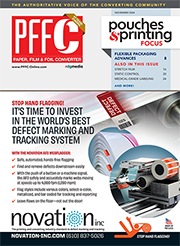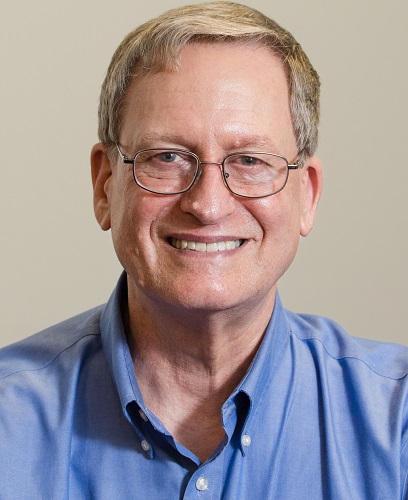Featured Stories
-
Static Control for Pouch, Bag and Label Lines
Solving Pouch Opening Failures and Preventing Stack Bricks -
-
Merging Innovation and Sustainability in Flexible Packaging
Optimizing Product Protection, Minimizing Material Usage
News | New Products
-
Pack-Smart Inc. Celebrates 25 Years of Packaging, Print Innovation
Pack-Smart Inc., a global leader in designing and manufacturing advanced automated solutions for digital print finishing and specialty packaging, celebrates its 25th anniversary milestone.
-
Print & Graphics Scholarship Foundation announces 2024/25 Academic Scholarships
The Print and Graphics Scholarship Foundation (PGSF), a nonprofit organization working to build the future workforce of the graphic communications industry through educational scholarships
-
Keypoint Intelligence Publishes 2023-2028 Outlook for the Wide Format Printing Market
Keypoint Intelligence, the leading provider of data-driven insights for the digital imaging industry, has released its latest report: Wide Format Print Forecast: 2023-2028.
-
AC Strapping Products Introduces STRAPBLASTER™ Technology for Cleaning Debris Buildup for Automated Strapping Machines
PAC Strapping Products, a leader in the strapping and packaging industry, is proud to introduce its latest innovation in strapping technology—STRAPBLASTER™ Technology.
-
Darryl Herbel Joins Flexo Wash as Western Territory Manager
Flexo Wash is honored to welcome Darryl Herbel as Western Territory Manager.
-
APR Releases New and Improved PCR Certification Program The seal of approval for post-consumer recycled plastics
The Association of Plastic Recyclers (APR) recently announced significant upgrades and improvements to the APR PCR Certification Program.
-
Starlinger acquires Woven Packaging Division from Windmöller & Hölscher
Austrian Starlinger & Co Gesellschaft m.b.H. has taken over the woven packaging division from German machinery producer Windmöller & Hölscher (W&H)
Expert Advice
Dutch converter expands in worldwide flex-pack market
- Published: February 01, 1995, By Sacharow, Stanley
KNP BT is Holland's largest producer and converter of packaging materials with $6.7 billion in worldwide sales.
Their headquarters are located in Hilversum in an architectural-showcase building designed by Richard Meier.
I interviewed Bert Paalman, a member of the firm's executive board and an engineer by profession. We talked about the future of flexible packaging and how KNP BT fits into Europe's global picture.
KNP BT ranked sixth in Pira's Top 10 European Packaging Companies. Formed by the 1993 merger of Buhrmann-Tetterode, KNP and VRG, the new firm is an international company active in the graphic, paper and packaging markets.
There are about 27,000 employees in 30 countries at 150 subsidiaries divided among 11 divisions and three strategic partly-owned companies.
Their packaging sector includes five divisions: flexible and protective packaging, solid board, Recycled Paper Europe, corrugated board, and Van der Windt. The firm supplies flexible and protective packaging, graphic, solid and paper for corrugated board. In June 1994, KNP BT acquired the flexible-consumer packaging activities of Stone Container Corp.
These packaging activities have been integrated with those of Sengewald USA, Marengo, IL. Since 1988, this KNP BT company has supplied high-quality printed flexible packaging, mainly for the nonfood sector. The production plants, which were acquired from Stone, are located in St. Paul, MN, and Grand Forks, ND, and concentrate on the production and sale of packaging for food products.
The takeover is in line with their policy to further strengthen its position in the US in flexible packaging. Product range, customer base and the total production capacity in flexible packaging will be extended considerably.
The flexible and protective packaging division of KNP BT now consists of 19 operating companies in Belgium, Canada, Egypt, France, Germany, Italy, the Netherlands, the UK and US.
According to Paalman, KNP BT's flex-pack activities worldwide amount to about $300 million in sales with 1,250 employees. Our conversation focused on their environmental thinking and how these concepts have permeated corporate activities.
"Source reduction is our main environmental concern. Even though there isn't much mandatory recycling in effect in Europe presently, the severe lack of landfills and increasing tipping fees make recycling a primary corporate goal," Paalman said. "We have identified a new entity which I call the Eurocustomer where a larger user firm, such as Procter and Gamble or Nestle, intend to purchase from limited global sources for all their plants."
Paalman said the thought that brand names now cross national boundaries and changes in consumer buying habits now favor the growth of larger suppliers over smaller national ones. Flexible packaging also appears to be favored because of source reduction as opposed to glass, metal or rigid plastic materials.
Even though the consolidation of packaging companies proceed slower in Europe than the US, it's coming on stronger because of user's global demands. Another trend mentioned was strategic alliances of large packaging suppliers, such as KNP BT with Bowater, UK, in corrugated packaging.
Paalman discussed the companies' specific activities in the flexible-packaging area along with Pat deLeede from KNP BT's corporate communications department.
Flexible packaging first became part of KNP BT's product mix in 1975 with the acquisition of Kobusch Packaging, Germany. Next was the 1988 acquisition of Sengewald, Germany, and Nordwest Packaging, Germany, 1990. In 1989 KNP BT, then only BT, built a Sengewald plant in Marengo, IL, to supply the flexible diaper bags for Procter and Gamble that had originally come from Sengewald's German operation.
With the acquisition of Stone Container's flexible-packaging operations, Sengewald's product mix, now serving the hygiene and food industries, are complemented by Stone's two plants serving mainly food packagers. Sengewald's three present plants are headquartered in Marengo, IL, and are headed by John Quinn.
We discussed the production differences between the US and Europe in the flexible-packaging market. Paalman mentioned flexo printing tends to be favored over gravure in Europe because of small run economies. As flexo quality increases, the technique is gaining popularity over gravure. Sengewald also does three-layer coextrusion in the US, laminates and prints polyethylene film. KNP BT's German operation is somewhat more sophisticated in coextrusion by producing a variety of up to six-layer constructions.
The firm's German operation, the largest in flexible packaging, consists of one Kobusch plant in Warburg, two Sengewald plants in Halle and Rohrdorf and one Nordwest plant in Lindlar. The Kobusch operation has a well-rounded flex-pack operation producing mainly polyethylene and polypropylene films using blown and flexo-printing techniques. They're presently producing a line of stand-up flexible pouches for the food industry.
The Sengewald German operation was a pioneer in extending the use of mono- and multilayer films to the meat and sausage industry. Its product range includes premade bags and pouches and printed roll stock.
The company has an assortment of cast and blown-film lines capable of producing polypropylene, polyethylene, and polyamide/polyethylene films which form the basis of the business.
In addition to extrusion coating, solvent and solvent-free lamination is carried out. Subsequent printing is by flexo or gravure. There are five printing machines capable of printing up to eight colors. Nordwest Packaging produces a variety of flexible materials based on paper.
In the Netherlands, KNP BT operates Form Plastics, Grootegast, which serves the agricultural industry with plastic-laminator bags. A west US plant also supplies printed oriented-polypropylene film for fresh flower packaging. Titentus, in Germany, produces polyethylene and oriented polypropylene film for flower packaging.
The latest KNP BT flexible-packaging converting plant is in Alexandria, Egypt. It's a fully-integrated converting operation producing diaper bags and detergent packaging as well as other products for the Egyptian food industry. Various joint ventures and alliances are also now being investigated in the former Soviet Bloc, specifically in Poland, Czech Republic and Hungary.
The flexible-packaging companies within the KNP BT corporation are heavily involved in R&D activities. Paalman discussed three areas of specific interest.
In the detergent field, there's a growing concentration of developing and marketing refillable packaging on a worldwide basis. Already a European trend, the firm is looking to expand into the US with a variety of concepts. He also discussed recent activities of Kobusch Packaging and Sengewald in Germany involving ultraviolet-flexo printing where ultraviolet light is used to dry flexo ink. This Revo printing is a newly-introduced technique at Kobusch and Sengewald. Kobusch also introduced solventless laminating, six-layer coextrusion targeted at the detergent market and stand-up pouches for a variety of products.
Paalman was enthusiastic about the future of flexible packaging. "Flexible packaging offers interesting possibilities for source reduction - for example, the stand-up pouch in all its many variations," he said. "KNP BT is fully committed to the flex-pack industry. It may very well be a growing center of interest to KNP BT."














